{#if:Script error: The function "findpagetext" does not exist. |
|
}}
| Dracula's Daughter | |
|---|---|
 Theatrical release poster by Karoly Grosz[2] | |
| Directed by | Lambert Hillyer |
| Written by | Suggested by: "Oliver Jeffries" (David O. Selznick) Treatment: John L. Balderston Kurt Neumann Contributing: R. C. Sherriff Peter Dunne Charles S. Belden[1] |
| Screenplay by | Garrett Fort |
| Story by | John L. Balderston[1] |
| Based on | "Dracula's Guest" (short story) by Bram Stoker |
| Produced by | E. M. Asher |
| Starring | Otto Kruger Gloria Holden Marguerite Churchill |
| Cinematography | George Robinson |
| Edited by | Milton Carruth |
| Music by | Heinz Roemheld |
Production company | |
| Distributed by | Universal Pictures |
Release dates | <templatestyles src="Plainlist/styles.css"/>
|
Running time | 69 or 72 minutes[1] |
| Country | United States |
| Language | English |
| Budget | $278,000[3] |
Dracula's Daughter is a 1936 American vampire horror film produced by Universal Pictures as a sequel to the 1931 film Dracula. Directed by Lambert Hillyer from a screenplay by Garrett Fort, the film stars Otto Kruger, Gloria Holden in the title role, Marguerite Churchill and features, as the only cast member to return from the original, Edward Van Sloan – although his character's name was altered from "Van Helsing" to "Von Helsing".
Dracula's Daughter tells the story of Countess Marya Zaleska, the daughter of Count Dracula and herself a vampire. Following Dracula's death, she believes that by destroying his body she will be free of his influence and live normally. When this fails, she turns to a psychiatrist, Dr. Jeffrey Garth (Otto Kruger). The Countess kidnaps Dr. Garth's fiancée, Janet (Marguerite Churchill), and takes her to Transylvania, leading to a battle between Dr. Garth and the Countess in an attempt by him to save Janet.
Ostensibly based on a deleted chapter from Bram Stoker's 1897 novel Dracula – published in 1937 as a short story under the name "Dracula's Guest"[1] – the film bears no resemblance to the source material. Modern sources also say that the film was loosely based on Carmilla, an 1872 Gothic novella by Joseph Sheridan Le Fanu, which is often cited as the first published British work of fiction to deal with lesbian relationships.[1]
David O. Selznick purchased the rights to the Stoker material for Metro-Goldwyn-Mayer, but Universal bought them in 1934, with the rights to revert to MGM if Universal did not begin production by October 1935, a date later extended to February 1936. Universal rushed the show into production in that month, with the script only partially completed, in order to meet this deadline.[1] The film was first assigned to James Whale, but Universal production head Carl Laemmle, Jr. finally put Hillyer in the director's chair.
While not as successful as the original upon its release, the film was generally well-reviewed. In the intervening decades, criticism has been deeply divided. Contemporary critics and scholars have noted the film's alleged lesbian overtones, which Universal exploited in some early advertising.
Plot[]
Dracula's Daughter begins a few moments after Dracula ends. Count Dracula has just been destroyed by Professor Von Helsing (Edward Van Sloan). Von Helsing is arrested by two Whitby policemen, Sergeant Wilkes (E. E. Clive) and constable Albert (Billy Bevan). Von Helsing is sent by the Whitby police to Scotland Yard, where he explains to Sir Basil Humphrey (Gilbert Emery) that he indeed did destroy Count Dracula, but because he had already been dead for over 500 years, it cannot be considered murder. Instead of hiring a lawyer, he enlists the aid of a psychiatrist, Dr. Jeffrey Garth (Otto Kruger), who was once one of his star students.
Sergeant Wilkes leaves the Whitby gaol to meet an officer from Scotland Yard at the train station. Meanwhile, Dracula's daughter, Countess Marya Zaleska (Gloria Holden), enters the gaol and mesmerizes Albert with her jeweled ring and with the aid of her manservant, Sandor (Irving Pichel), steals Dracula's body from the Whitby gaol and after tossing salt on the pyre ritualistically burns Dracula's body, hoping to break her curse of vampirism. However, Sandor soon begins to discourage her telling her that all that is in her eyes is "death." She soon gives in to her thirst for blood. The Countess resumes her hunting, mesmerizing her victims with her exotic jeweled ring. After a chance meeting with Dr. Garth at a society party, the Countess asks him to help her overcome the influence she feels from beyond the grave. The doctor advises her to defeat her cravings by confronting them and the Countess becomes hopeful that her will, plus Dr. Garth's science, will be strong enough to overcome Dracula's malevolence.
The Countess sends Sandor to fetch her a model to paint. He sees a pretty young woman, Lili (Nan Grey), and follows her onto a bridge. The woman pauses at the railing looking despondent. Sandor promises her food, warmth and money. She hesitates, but Sandor explains that he seeks her for his mistress. Lili returns with Sandor. Countess Zaleska initially resists her urges but succumbs and attacks her. Lili survives the attack and is examined by Dr. Garth through hypnosis; she reveals enough information to let Dr. Garth know that it was Countess Zaleska that attacked her, but suffers heart failure and dies. The Countess gives up fighting her urges and accepts that a cure is not possible; she lures Dr. Garth to Transylvania by kidnapping Janet Blake (Marguerite Churchill), his secretary, whom he has a playfully antagonistic relationship with, but now realizes that he cares for her. Zaleska intends to transform Dr. Garth into a vampire to be her eternal companion. Arriving at Castle Dracula in Transylvania, Dr. Garth agrees to exchange his life for Janet's. Before he can be transformed, Countess Zaleska is destroyed when Sandor shoots her through the heart with an arrow as revenge for her breaking her promise to make him immortal. He takes aim at Dr. Garth but is shot dead by a Scotland Yard policeman who, along with Von Helsing, have followed Dr. Garth from London.
Cast[]
- Otto Kruger as Dr. Jeffrey Garth
- Gloria Holden as Countess Marya Zaleska, Dracula's daughter
- Marguerite Churchill as Janet Blake
- Irving Pichel as Sandor
- Halliwell Hobbes as Hawkins
- Billy Bevan as Albert
- Nan Grey as Lili
- Hedda Hopper as Lady Esme Hammond
- Claud Allister as Sir Aubrey
- Gilbert Emery as Sir Basil Humphrey, Scotland Yard
- Edward Van Sloan as Professor Von Helsing
- Edgar Norton as Hobbs, Sir Humphrey's butler
- E. E. Clive as Sergeant Wilkes
- Christian Rub as Coachman (uncredited)
- Vernon Steele as Squires (uncredited)
- Fred Walton as Dr. Beemish (uncredited)
Source:[1]
Production[]
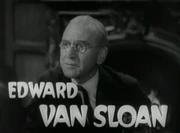
Edward Van Sloan as Von Helsing
Universal originally did not hold the rights to "Dracula's Guest", a chapter excised from Bram Stoker's original novel, which was published in 1937, after Stoker's death, as a short story and which was the purported source material for the film. Metro-Goldwyn-Mayer executive David O. Selznick negotiated a contract in 1933 with Stoker's widow, Florence, to buy the rights to the chapter for an advance of $500 against a purchase price of $5,000. MGM's lawyers and executives were worried about the use of the word "Dracula" in the film's title, fearing that Universal would take legal action, although Selznick's contract with Stoker explicitly listed "Dracula's Daughter" as a possible alternative title. The project was code-named "Tarantula" in correspondence.[4] Universal bought the right from MGM in 1934, but they would revert to MGM if Universal did not begin production by October 1935, a date later extended to February 1936. Universal rushed the show into production in that month, with the script only partially completed, in order to meet this deadline.[1]
Modern sources report that the film was also loosely based on Carmilla, an 1872 Gothic novella by Joseph Sheridan Le Fanu, which is often cited as the first published British work of fiction to deal with lesbian relationships.[1]
Selznick hired John L. Balderston, who had previously worked on the 1931 Dracula and Frankenstein, to write the screenplay. Balderston's screenplay involved tying up loose ends from the original film. In it, Von Helsing returns to Transylvania to destroy the three vampire brides seen in Dracula but overlooks a fourth tomb concealing Dracula's daughter. She follows him back to London and operates under the name "Countess Szekelsky". She attacks a young aristocrat and Von Helsing and the aristocrat's fiancée track her back to Transylvania and destroy her. The script included scenes that implied that Dracula's daughter enjoyed torturing her male victims and that while under her control the men liked it too. Also included were shots of the Countess's chambers being stocked with whips and straps, which she would never use on-screen but whose uses the audience could imagine. Regardless of any objections that the Production Code Administration (PCA) would have raised to many aspects of the scenario, Balderston's script could never have been filmed because Selznick's contract with Stoker expressly barred him from using any Bram Stoker characters that did not appear in "Dracula's Guest". Selznick re-sold the rights to "Dracula's Guest" to Universal in October 1934[1] or September 1935[4] for $12,500, which included the rights to Balderston's scenario.[5] Horror film scholar David J. Skal theorizes that this was Selznick's actual motivation in buying the rights in the first place, to profit from Universal's desire for a sequel by tying up the only obvious source material.[6] A condition of the sale was that the rights would revert to MGM if Universal did not start production by October 1935, later extended to February 1936.[1]
Director[]
Universal studio head Carl Laemmle, Jr. (nicknamed "Junior") wanted James Whale, fresh from his great success with Bride of Frankenstein, to direct Dracula's Daughter. Whale was idle, waiting for Irene Dunne to finish work on Magnificent Obsession so she could begin work on Whale's Show Boat. Wary of directing two horror films in a row, Whale instead convinced Laemmle to buy the rights to a mystery novel called The Hangover Murders. Laemmle agreed only after extracting a promise from Whale that he would direct Dracula's Daughter next.[7] Whale completed work on the film, Remember Last Night?, on September 14, 1935.[8] Magnificent Obsession completed filming on October 29. With Dunne freed up, Whale went to work on Show Boat. Laemmle replaced him with A. Edward Sutherland, who was best known for his work on comedies. Sutherland had as little interest in Dracula's Daughter as Whale did and soon left the studio,[9] so Hillyer came on to direct.
Universal script[]
A treatment by John L. Balderston was submitted to Universal in January 1934, and may have been presented to MGM earlier. Another short treatment by Kurt Neumann was rejected by Universal.[1]
The earliest screenplay for the Universal film was written by R. C. Sherriff and submitted in July 1935.[1] It began with three scenes set in the 14th Century and centered on the Dracula legend. It then switched to the present day, focusing on two engaged couples who visit Transylvania. The men explore the ruins of Dracula's castle. One is later found, insane, and the other goes missing. Professor Von Helsing is summoned and he tracks the missing man to London, where he is in thrall to Dracula's daughter, the Countess Szelinski (sic). When she attempts to flee with her thrall to the Orient by ship, Von Helsing and three others book passage on the same ship. During a violent storm, Von Helsing destroys Dracula's daughter and, with her hold over the men broken, the scenario closes with a double wedding. This version was submitted on August 28, 1935 to the British Board of Film Censors, which rejected it, saying in part "... Dracula's Daughter would require half a dozen ... languages to adequately express its beastliness." On September 10 Sherriff met with BBFC representatives and submitted a revised scenario two days later. This scenario was passed but because its details were not recorded by the BBFC it is unknown how much it differed from the original or how much if any of that scenario was retained in the final script.[10]
Universal submitted Sheriff's first draft to the Production Code Administration (PCA) on September 5, 1935 and encountered stronger resistance from PCA head Joseph Breen than it had from the British. Breen reported back that the script "contains countless offensive stuff which makes the picture utterly impossible for approval under the Production Code".[11] A second draft was submitted on October 21, but it too was rejected, with many of Breen's objections centering on the 14th Century scenes in which Dracula himself appeared. It is unclear whether this submission was the same submission that the BBFC had previously passed. A third Sheriff draft was submitted three days later and Sherriff's fourth and final draft on November 10. All remained unacceptable, and Whale biographer James Curtis suggests that Whale, who had no interest in the project and feared that his commitment to it might cost him control over the filming of Show Boat, encouraged Sherriff to submit ever more wildly unacceptable versions in hopes of getting himself off the film.[5] On January 14, 1936, producer E. M. Asher advised Breen that the Sherriff script was not going to be used and that a new script would be put together from scratch.[12]
Screenwriting duties were then assigned to Garrett Fort,[12] who submitted a draft in January 1936, and a second draft in February. Asher, Fort and Universal executive Harry Zehner meet with Production Code officials in February 1936, during which Universal was asked that the scene in which Lili poses for Marya be written so that there was no suggestion that Lili was nude, or that there was any indication of a "perverse sexual desire on the part of Marya or of an attempted sexual attack by her upon Lili."[1]
Fort's February draft, as revised by Charles Belden in March 1936, seems to be the version used to shoot the film, which was viewed and passed by the PCA in April 1936. Fort is the only one of the various writers to receive screen credit along with Stoker.[1]
Casting[]
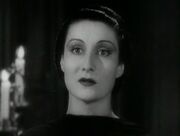
Gloria Holden
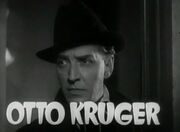
Dracula's Daughter was Gloria Holden's first starring role and reportedly she was extremely displeased at having been assigned it. Like many actors, Holden looked down on horror films. She had also seen Bela Lugosi struggle over the years since Dracula was made to free himself from typecasting and feared that the role would lead to the same fate for her. Critic Mark Clark believes that ironically it may have been Holden's disgust for the role that led to the quality of her performance. "Her disdain for the part translates into a kind of self-loathing that perfectly suits her troubled character."[13]
Initially Lugosi and Jane Wyatt were set to star in the film. Universal also announced that Boris Karloff and Colin Clive, who had starred together in Frankenstein and Bride of Frankenstein, would appear,[14] and that Cesar Romero would play Dr. Garth.[15] According to The Hollywood Reporter, Universal had sought Herbert Marshall for the role of Sandor, before casting Pichel.[15] None of them appeared except, after a fashion, Lugosi, in the form of a wax bust molded in his image for use in Dracula's coffin. Some sources report that Lugosi was paid as much as $4,000 for his abortive involvement, but the only confirmed record of any financial arrangement is a letter in which Lugosi consents to the use of his likeness at no cost to create the wax bust.[14]
Shooting[]
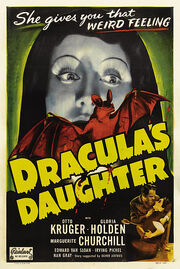
Theatrical poster
Shooting on Dracula's Daughter began on February 4, 1936, rushed into production before Fort had completed the script,[16] because of a deadline clause in Universal's option of the property from Selznick.[17] The script was not finalized until shooting had been underway for three weeks.[18] The film was completed on March 10.[19] Despite studio orders that the film be shot on a seven-day-per-week schedule,[18] filming ran seven days over its schedule and $50,000 over budget, with the final cost of the film tallied at $278,380.[20]
Dracula's Daughter was the last in the first cycle of Universal Horror films that reached back into the 1920s. Publicly, Universal said it was because a British ban on horror films would cut too deeply into the revenue such films could generate.[21] In truth, the cycle was suspended because, just before filming on Dracula's Daughter had wrapped, the Laemmle family had lost control of Universal. Because of cost overruns on a number of pictures, Junior Laemmle was forced to borrow $1,000,000 on November 1, 1935. The money came from J. Cheever Cowdin, head of the Standard Capital Corporation, and from Charles R. Rogers. When the loan was called in March of the following year, Universal was unable to repay it. Standard assumed control of the studio on March 4 and Rogers replaced Junior as head of production. Rogers did not like horror films and he shut down production on them following the release of Dracula's Daughter to focus on fare like Deanna Durbin musicals.[22] Universal would not return to the horror genre for three years, when it released Son of Frankenstein in 1939.
Other production aspects[]
Makeup artist Jack Pierce and special effects supervisor John P. Fulton worked together closely, especially on Holden's make-up design. They combined special lighting with a greyish-green make-up for Holden's final scenes, creating a pallor that contrasted with the more normally flesh-toned make-ups of the others in the scene.[23] Heinz Roemheld composed the score[18] and Albert S. D'Agostino redressed Charles D. Hall's set of Dracula's castle and created new sets including a London bridge, the moor where Dracula's body is burned and Countess Zaleska's apartment.[24]
Critical response[]
The New York Times gave Dracula's Daughter a solid, albeit somewhat tongue-in-cheek, review upon its release, citing the film's "blood-curdling events" and noting that "Gloria Holden is a remarkably convincing bat-woman" in concluding that the film is both "quite terrifying" and "a cute little horror picture."[25] Variety also praised the production and Holden's performance in particular.[26] Despite critical approval, Dracula's Daughter did not have the same box office success as the original.
Later reviews of Dracula's Daughter are sharply split. Entertainment Weekly, reviewing the film following its video release, called it "one of the most satisfying vampire pictures ever made". Describing director Hillyer's visuals as "lush, evocative, and suffused with just the right gothic chiaroscuro" and noting that "Gloria Holden, as the reluctant vampire protagonist, absolutely drips patrician eroticism", EW concludes that this film is better than Lugosi's original Dracula.[27]
Ryan Cracknell of Apollo Movie Guide, while echoing the praise for Holden's performance, nonetheless found that the film "doesn't hold up so well today". Citing what he sees as slow pacing and "long bouts of over-the-top dialogue", Cracknell compares the film to "reading a textbook – not the most exciting thing in the world, but it does provide insights into and perspectives on the foundation of early horror movies and how many similarities carry over into movies half a century and more later."[28] Michael W. Phillips, Jr. concurs, calling the film "a marked improvement on the original film [but] still a bit of a snooze, relying too much on forced comedy and not enough on suspense or fright."[29] Phillips again praises Holden's performance and also Pichel's portrayal of Sandor, but finds the rest of the cast weak.
Influence[]
Horror author Anne Rice has named Dracula's Daughter as a direct inspiration for her own homoerotic vampire fiction.[30] She named a bar in her novel The Queen of the Damned "Dracula's Daughter" in honor of the film.[31] Author Ramsey Campbell, under the pseudonym "Carl Dreadstone", wrote a novelization of the film also entitled Dracula's Daughter that was published in 1977.[32] A juvenile fiction version, written by Carl R. Green, William R. Sanford and Howard Schroeder, was published in 1985.[33] Some observers have suggested that the film served as an inspiration for Sunset Blvd., noting similarities between the outlines of each film.[34] Michael Almereyda's 1994 film Nadja has been described as an "unofficial remake" of Dracula's Daughter.[35]
Lesbian implications[]
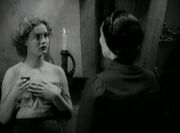
"Save the women of London from Dracula's Daughter!" Countess Zaleska seduces Lili.
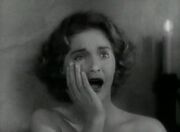
Nan Gray
The lesbian vampire has been a trend in literature dating back to Joseph Sheridan le Fanu's 1872 novella "Carmilla". Dracula's Daughter marked the first time that the trend was incorporated into a film.[36] The lesbian implications of Dracula's Daughter were obvious from the start and were of great concern to the Production Code Administration. PCA head Breen took special notice of the scene between the Countess and her model, Lili, writing, "This will need very careful handling to avoid any questionable flavor."[37] The day before the scene was to be shot, Universal's Harry Zehner asked Breen to read a draft of the scene. In response, Breen wrote:
The present suggestion that ... Lili poses in the nude will be changed. She will be posing her neck and shoulders, and there will be no suggestion that she undresses, and there will be no exposure of her person. It was also stated that the present incomplete sequence will be followed by a scene in which Lili is taken to a hospital and there it will be definitely established that she has been attacked by a vampire. The whole sequence will be treated in such a way as to avoid any suggestion of perverse sexual desire on the part of Marya or of an attempted sexual attack by her upon Lili.[37]
Gay film historian Vito Russo noted in his book The Celluloid Closet that Universal highlighted Countess Zaleska's attraction to women in some of its original advertising for the film, using the tag line "Save the women of London from Dracula's Daughter!" He further cited Countess Zaleska as an example of the presentation of the "essence of homosexuality as a predatory weakness".[38] Some reviewers of the day picked up on and condemned the lesbian content, including the New York World-Telegram which noted the Countess's tendency to wander around "giving the eye to sweet young girls".[39] Other reviews missed it entirely, including the aforementioned The New York Times which advised "Be sure to bring the kiddies."[25] Entertainment Weekly describes the encounter between the Countess and Lili as "so hot it's impossible to imagine how it ever got past '30s censors"[27] whereas Time Out London finds only a "subtle suggestion" of lesbianism.[40] Horror scholar Skal notes that the scene has come to be seen as a "classic 'lesbian' sequence, although of a decidedly negative stripe".[41] The scene between Countess Zaleska and Lili was included in the 1995 documentary film adaptation of Russo's book.
Another lesbian-tinged scene which has received less critical attention comes when the Countess is holding Janet captive. Described as "the longest kiss never filmed", Countess Zaleska "hovers lovingly over Janet ... hovers ... and hovers ... slowly descending to kiss the recumbent Janet ..."[42] until interrupted by the arrival of Dr. Garth.
Bright Lights Film Journal, after noting that "Gloria Holden in the title role almost singlehandedly redefined the '20s movie vamp as an impressive Euro-butch dyke bloodsucker", draws an implicit comparison between Countess Zaleska's seeking to cure her vampirism through psychiatry and the former position of mainstream psychiatry of homosexuality as a mental illness. Zaleska's cruising the streets of London is seen as parallel to cruising for sex (although that tends to be a gay male activity) and as suggesting "society's image of the lesbian as soulless predator" but the conclusion is that "Holden's striking, masklike face and haunting, luminous eyes [are] the intoxicating essence of transgressive lesbian power."[43]
See also[]
References[]
Notes
- ↑ 1.00 1.01 1.02 1.03 1.04 1.05 1.06 1.07 1.08 1.09 1.10 1.11 1.12 1.13 1.14 1.15 Dracula's Daughter at the American Film Institute Catalog
- ↑ Branaghan & Chibnall, p. 47
- ↑ Brunas, et al., p. 159
- ↑ 4.0 4.1 Skal, pp. 196–98
- ↑ 5.0 5.1 Curtis, p. 260
- ↑ Skal, p. 196
- ↑ Curtis, pp. 254–55
- ↑ Curtis, p. 258
- ↑ Curtis, pp. 260–61
- ↑ Robertson pp. 65–66
- ↑ Breen, quoted in Skal, p. 198
- ↑ 12.0 12.1 Skal, pp. 198–99
- ↑ Clark, p. 184
- ↑ 14.0 14.1 Rhodes, p. 219
- ↑ 15.0 15.1 Mank, p. 365
- ↑ Mank, p. 356
- ↑ Skal, p. 199
- ↑ 18.0 18.1 18.2 Mank, p. 357
- ↑ Mank, p. 358
- ↑ Senn, p. 361
- ↑ Johnson, p. 7
- ↑ Johnson, p. 129
- ↑ The New York Times, "Vampires, Monsters, Horrors!" March 1, 1936. Quoted in White, pp. 147–48
- ↑ Bansak, et al., p. 113
- ↑ 25.0 25.1 Nugent, Frank S. (1936-05-18). "THE SCREEN; ' Dracula's Daughter' Makes Her Debut at the Rialto and Proves She's a Chip Off the Old Block.". The New York Times. https://movies.nytimes.com/movie/review?_r=2&res=9E00EFDF1230E13BBC4052DFB366838D629EDE&partner=Rotten%20Tomatoes&oref=slogin. Retrieved 2008-11-03.
- ↑ Clark, p. 188
- ↑ 27.0 27.1 Simels, Steve (1992-12-11). "Dracula's Daughter". Entertainment Weekly. http://www.ew.com/ew/article/0,,20197299,00.html. Retrieved 2008-11-03.
- ↑ Cracknell, Ryan. "Dracula's Daughter". Apollo Movie Guide. Archived from the original on 2009-02-06. Retrieved 2008-11-07.<templatestyles src="Module:Citation/CS1/styles.css"></templatestyles>
- ↑ Phillips, Jr., Michael W. "Dracula's Daughter". goatdog.com. Retrieved 2008-11-07.<templatestyles src="Module:Citation/CS1/styles.css"></templatestyles>
- ↑ Hoppenstand, et al., p. 14
- ↑ Skal, David J.. "Bloodsuckers and Cocksuckers: A Glossary of Vampirism and Sex". Bright Lights Film Journal #15: p. 11.
- ↑ Melton, p. 791
- ↑ Green, Carl R.; William R. Sanford and Howard Schroeder (1985). Dracula's Daughter. Silver Burdett Press. ISBN 0-89686-260-7.
- ↑ Keesey, p. 82
- ↑ Abbott, p. 145
- ↑ Tudor, p. 31
- ↑ 37.0 37.1 Breen, quoted in Worland, p. 126
- ↑ Russo, p. 48
- ↑ quoted in Russo, p. 48
- ↑ "Dracula's Daughter". Time Out London. Archived from the original on 2009-02-06. https://web.archive.org/web/20090206164857/http://www.timeout.com/film/reviews/65746/Draculas_Daughter.html. Retrieved 2008-11-03.
- ↑ Skal, p. 200
- ↑ Hanson, pp. 198–99
- ↑ Morris, Gary (December 1998). "Queer Horror: Decoding Universal's Monsters". Bright Lights Film Journal. http://brightlightsfilm.com/23/universalhorror.php. Retrieved 2014-04-21.
Bibliography
- Abbott, Stacey (2007). Celluloid Vampires: Life After Death in the Modern World. University of Texas Press. ISBN 978-0-292-71695-7. https://books.google.com/books?id=_cBhLk-0PKAC&printsec=frontcover&source=gbs_ge_summary_r&cad=0#v=onepage&q&f=false.
- Bansak, Edmund G. and Robert Wise (2003). Fearing the Dark: The Val Lewton Career. McFarland. ISBN 0-7864-1709-9.
- Branaghan, Sim; Chibnall, Stephen (2006). British Film Posters: An Illustrated History. United Kingdom: Cambridge University Press. ISBN 1-84457-221-8.
- Brunas, Michael, John Brunas & Tom Weaver (1990). Universal Horrors: The Studios Classic Films, 1931-46. McFarland.
- Clark, Mark (2004). Smirk, Sneer and Scream: Great Acting in Horror Cinema. McFarland. ISBN 0-7864-1932-6.
- Curtis, James (1998). James Whale: A New World of Gods and Monsters. Boston, Faber and Faber. ISBN 0-571-19285-8.
- Hanson, Ellis (1999). Out Takes: Essays on Queer Theory and Film. Duke University Press. ISBN 0-8223-2342-7. https://books.google.com/books?id=jsTGlJ88xA0C&printsec=frontcover&source=gbs_ge_summary_r&cad=0#v=onepage&q&f=false.
- Johnson, Tom (1997). Censored Screams: The British Ban on Hollywood Horror in the Thirties. McFarland. ISBN 0-7864-0394-2.
- Keesey, Pam (1997) Vamps: An Illustrated History of the Femme Fatale. San Francisco, Cleis Press. ISBN 1-57344-026-4.
- Mank, Gregory W. (1999) Women in Horror Films, 1930s. McFarland. ISBN 0-7864-0553-8.
- Melton, J. Gordon (1994). The Vampire Book: The Encyclopedia of the Undead. Detroit, Visible Ink Press (a division of Gale Research, Inc.). ISBN 0-8103-2295-1.
- Rhodes, Gary Don (1997). Lugosi: His Life in Films, on Stage, and in the Hearts of Horror Lovers. McFarland. ISBN 0-7864-0257-1.
- Hoppenstand, Gary, and Ray Broadus Browne (1996) The Gothic World of Anne Rice. Popular Press. ISBN 0-87972-708-X.
- Robertson, James Crighton (1993). The Hidden Cinema: British Film Censorship in Action, 1913–1975. Routledge. ISBN 0-415-09034-2.
- Russo, Vito (1987). The Celluloid Closet: Homosexuality in the Movies (revised edition). New York, HarperCollins. ISBN 0-06-096132-5.
- Senn, Bryan (1996). Golden Horrors: An Illustrated Critical Filmography of Terror Cinema, 1931–1939. McFarland. ISBN 0-7864-0175-3.
- Skal, David J. (1993). The Monster Show: A Cultural History of Horror. Penguin Books. ISBN 0-14-024002-0.
- Tudor, Andrew (1989). Monsters and Mad Scientists: A Cultural History of the Horror Movie. Blackwell Publishing. ISBN 0-631-16992-X.
- White, David Manning (1975). Popular Culture. Ayer Publishing. ISBN 0-405-06649-X.
- Worland, Rick (2007). The Horror Film: An Introduction. Blackwell Publishing. ISBN 1-4051-3902-1.
Further reading
- Rhodes, Gary D.; Weaver, Tom; et al. (2017) Scripts from the Crypt: Dracula's Daughter. BearManor. ISBN 9781629331164
- Includes script and pressbook
External links[]
| Wikiquote has quotations related to: Dracula's Daughter |
- Dracula's Daughter at the American Film Institute Catalog
- Dracula's Daughter at the Internet Movie Database
- Dracula's Daughter at the TCM Movie Database
- Dracula's Daughter at AllRovi
- Dracula's Daughter at Rotten Tomatoes
- The Universal Dracula series
| Bram Stoker's Dracula | ||
|---|---|---|
| Characters | Original novel | Count Dracula • Abraham Van Helsing • Jonathan Harker • Mina Harker • Lucy Westenra • Arthur Holmwood • Dr. John Seward • Quincey Morris •
Renfield • Brides |
| Other works | Adri Nital • Alucard • Count Alucard • Count Orlok • Count von Count • Dracula (Teenage Mutant Ninja Turtles) • Doctor Sun • Eva • Hamilton Slade • Janus • Postmortem • Turac | |
| Historical | Vlad Călugărul • Vlad the Impaler • Vlad II Dracul | |
| Films | Universal series |
Dracula (1931 English-language) • Drácula (1931 Spanish-language) • Dracula's Daughter (1936) • Son of Dracula (1943) • House of Frankenstein (1944) • House of Dracula (1945) • Abbott and Costello Meet Frankenstein (1948) |
| Hammer series |
Dracula (1958) • The Brides of Dracula (1960) • Dracula: Prince of Darkness (1966) • Dracula Has Risen from the Grave (1968) • Taste the Blood of Dracula (1970) • Scars of Dracula (1970) • Dracula A.D. 1972 (1972) • The Satanic Rites of Dracula (1973) • The Legend of the 7 Golden Vampires (1974) | |
| Dracula 2000 |
Dracula 2000 (2000) • Dracula II: Ascension (2003) • Dracula III: Legacy (2005) | |
| Parodies | Mad Monster Party? (1967) • Batman Fights Dracula (1967) • Blacula (1972) • Mad Mad Mad Monsters (1972) • Blood for Dracula (1974) • Vampira (1974) • Son of Dracula (1974) • Dracula in the Provinces (1975) • Dracula and Son (1976) • Love at First Bite (1979) • The Halloween That Almost Wasn't (1979) • Fracchia contro Dracula (1985) • The Monster Squad (1987) • Scooby-Doo! and the Reluctant Werewolf (1988) • Dracula: Dead and Loving It (1995) • Monster Mash (1995) • Monster Mash (2000) • Zora the Vampire (2000) • Hotel Transylvania (2012) • Hotel Transylvania 2 (2015) | |
| Other | Dracula's Death (1921) • Nosferatu (1922) • The Return of the Vampire (1943) • Drakula İstanbul'da (1953) • Blood of Dracula (1957) • The Return of Dracula (1958) • Batman Dracula (1964) • Billy the Kid Versus Dracula (1966) • Dracula (1968) • Blood of Dracula's Castle (1969) • Count Dracula (1970) • Los Monstruos del Terror (1970) • Cuadecuc, vampir (1971) • Vampyros Lesbos (1971) • Dracula vs. Frankenstein (1971) • Bram Stoker's Dracula (1973) • Count Dracula's Great Love (1974) • Count Dracula (1977) • Dracula's Dog (1978) • Doctor Dracula (1978) • Nosferatu the Vampyre (1979) • Dracula (1979) • Nocturna: Granddaughter of Dracula (1979) • Dracula's Widow (1988) • To Die For (1989) • Sundown: The Vampire in Retreat (1989) • Bram Stoker's Dracula (1992) • Nadja (1994) • Shadow of the Vampire (2000) • Dark Prince: The True Story of Dracula (2000) • Dracula: Pages from a Virgin's Diary (2002) • Dracula (2002) •
The League of Extraordinary Gentlemen (2003) • Van Helsing (2004) • Van Helsing: The London Assignment (2004) • Dracula 3000 (2004) • The Vulture's Eye (2004) • Blade: Trinity (2004) • The Batman vs. Dracula (2005) • Bram Stoker's Dracula's Curse (2006) • Dracula (2006) • Bram Stoker's Dracula's Guest (2008) • The Librarian: Curse of the Judas Chalice (2008) • House of the Wolf Man (2009) • Young Dracula (2011) • Dracula Reborn (2012) • Dracula 3D (2012) • Saint Dracula 3D (2012) • Dracula 2012 (2013) • Dracula: The Dark Prince (2013) • Dracula Untold (2014) | |
| Television | Series | Draculas ring (1978) • Cliffhangers (1979) • Drak Pack (1980) • Count Duckula (1988–1993) • Dracula: The Series (1990–1991) • Little Dracula (1991–1999) • Ace Kilroy (2011–2012) • Young Dracula (2006–2014) (characters • episodes) • Dracula (2013–2014) • Penny Dreadful (2014–2016) |
| Episodes | "Treehouse of Horror IV" (1993) • "Treehouse of Horror XXI" (2010) • "Buffy vs. Dracula" (2000) • "The Crypt of Dracula" ((smaller|2017}} | |
| Other novels |
The Dracula Tape and sequels (1975–2002) • Anno Dracula series (1992–present) (Anno Dracula • The Bloody Red Baron • Dracula Cha Cha Cha) • Dracula's Guest and Other Weird Stories (1914) • The Revenge of Dracula (1978) • Little Dracula (1986) • Dracula the Undead (1997) • The Historian (2005) • The Book of Renfield (2005) • Bloodline (2005) • Young Dracula and Young Monsters (2006) • Fangland (2007) • Dracula the Un-dead (2009) | |
| Plays | Dracula (1924) • Dracula (1995) • Dracula (1996) | |
| Musicals | Dracula (Czech musical) (1995) • Dracula: A Chamber Musical (1997) • Dracula, the Musical (2004) • Dracula – Entre l'amour et la mort (2006) • Dracula: the Musical (2010) • Dracula – L'amour plus fort que la mort (2011) | |
| Comics | The Tomb of Dracula • Dracula (Marvel Comics) • Dracula (Dell Comics) • Dracula Lives • Hellsing • The League of Extraordinary Gentlemen • Sword of Dracula • Batman & Dracula: Red Rain • Victorian Undead • Wolves at the Gate • X-Men: Apocalypse vs. Dracula • Purgatori | |
| Video games |
The Count (1981) • Ghost Manor (1983) • Castlevania series (1986–present • Dracula) • Dracula (1986) • Dracula the Undead (1991) • Dracula Hakushaku (1992) • Bram Stoker's Dracula (1993) • Bram Stoker's Dracula (handheld) (1993) • Dracula Unleashed (1993) • Dracula: Resurrection (2000) • Dracula 2: The Last Sanctuary (2000) • Van Helsing (2004) • Dracula 3: The Path of the Dragon (2008) • Dracula: Origin (2008) • Vampire Season Monster Defense (2012) • Dracula 4: The Shadow of the Dragon (2013) • Dracula 5: The Blood Legacy (2013) • The Incredible Adventures of Van Helsing (2013) • Drac's Night Out (unreleased) | |
| Pinball | Dracula (1979) • Bram Stoker's Dracula (1993) • Monster Bash (1998) | |
| Other games | The Fury of Dracula | |
| Castles | Castle Dracula • Bran Castle • Poenari Castle • Corvin Castle | |
| Albums | Dracula • Dracula 2000 • Iubilaeum Anno Dracula 2001 • Perfect Selection: Dracula Battle • Transylvania • Van Helsing | |
| Songs | "Love Song for a Vampire" | |
| Audio dramas | Legend of the Cybermen | |
| Related topics | Dracula in popular culture • Don Dracula • Transylvanian Society of Dracula • Dracula Society • Dracula tourism • Lugosi v. Universal Pictures • "Dracula/The Rose" | |
Template:Lambert Hillyer